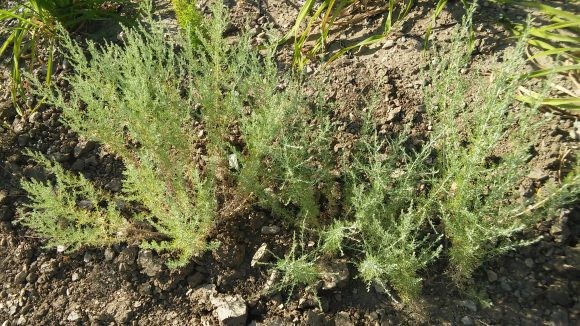CHEMICAL COMPOSITION OF THE ESSENTIAL OIL OF WORMWOOD TAURIA, GROWING IN THE ASTRAKHAN REGION
UDC 665.572.9:543.544.45
Abstract
Using the steam distillation method, essential oil samples were obtained from the ground part of Artemisia taurica Willd., which grows wild in the Astrakhan region, and the dependence of its yield on the growing season of the plant was studied. The duration of the steam distillation process was established experimentally based on the study of the dynamics of changes in the yield of essential oil over time. The yield of essential oil was determined in % in terms of the weight of air-dry raw materials. The highest yield of essential oil was obtained from plants in the flowering phase (0.57–0.59%). Quantitative analysis of the main components of Artemisia taurica essential oil was carried out by GC-MS. The quantitative content of essential oil components was calculated from the areas of gas chromatographic peaks without using correction factors. Qualitative analysis was performed by comparing linear retention indices. It has been established that the composition of the essential oil of Artemisia taurica, which grows on the territory of the natural "Bogdinsko-Baskunchaksky" reserve of the Astrakhan region, is very specific. In the essential oil, 41 compounds belonging to various classes have been identified. It includes monoterpene hydrocarbons (6.57%), monoterpenoids (65.17%), sesquiterpene hydrocarbons (4.87%), sesquiterpenoids (1.85%), as well as fatty acids and acid esters (13.93%) and carbonyl compounds (4.04%). The main components of the essential oil are camphor (24.50%), borneol (8.70%), iso-dihydrocarveol (4.11%), mertinal (3.67%), terpene-4-ol (3.35%). Unlike the taxon Artemisia taurica growing in the Crimea, the studied essential oil contains a small amount of a-thujone (1.32%).
Downloads
Metrics
References
Khanina M.A., Serykh Ye.A., Pokrovskiy M.M., Tkachev A.V. Khimiya rastitel'nogo syr'ya, 2000, no. 3, pp. 3340. (in Russ.).
Ekier H., Świątkowska J., Klin P., Rzepiela A., Szopa A. Planta Med., 2021, vol. 87, pp. 584599. DOI: 10.1055/a-1345-9528.
Anibogwu R., Jesus K., Pradham S., Pashikanti S., Mateen S., Sharma K. Molecules, 2021, vol. 26, p. 6995. DOI: 10.3390/molecules26226995.
Khanina M.A., Serykh Ye.A., Pokrovskiy M.M., Tkachev A.V. Khimiya rastitel'nogo syr'ya, 2000, no. 3, pp. 7784. (in Russ.).
Alyakin A.A., Yefremov A.A., Angaskiyeva A.S., Grebennikova V.V. Khimiya rastitel'nogo syr'ya, 2011, no. 3, pp. 123127. (in Russ.).
Velikorodov A.V., Morozova L.V., Pilipenko V.N., Kovalev V.B. Khimiya rastitel'nogo syr'ya, 2011, no. 4, pp. 115120. (in Russ.).
Velikorodov A.V., Kovalev V.B., Nosachev S.B., Tyrkov A.G., Pitelina M.V., Shchepetova E.V. Chemistry and Technology of Plant Substances: Chemical and Biochemical Aspects. New York: Apple Academic Press, 2017, pp. 309–335.
Levina F.Ya. Botanicheskiy zhurnal, 1963, vol. 48, no. 3, pp. 422–426. (in Russ.).
Safronova I.N. Geobotanicheskoye kartografirovaniye, 2002, no. 2001-2002, pp. 44–65. (in Russ.).
Safronova I.N. Sostoyaniye i mnogoletniye izmeneniya prirodnoy sredy na territorii Bogdinsko-Baskunchakskogo zapovednika: monografiya. [State and long-term changes in the natural environment on the territory of the Bogdinsko-Baskunchaksky reserve: monograph]. Volgograd, 2012, pp. 103–128. (in Russ.).
Safronova I.N. Ekologiya i geografiya rasteniy i rastitel'nykh soobshchestv: materialy IV Mezhdunarodnoy nauchnoy konferentsii. [Ecology and geography of plants and plant communities: materials of the IV International Scientific Con-ference]. Yekaterinburg, 2018, pp. 860863. (in Russ.).
Kurșat M., Civelek S., Sancar P.Y., Turkoglu I. Biol. Divers. Conservation., 2018, vol. 11, pp. 106114.
Tabur S., Kurșat M., Öney S., Özmen S., Civelek Ș. Caryologia, 2014, vol. 67, pp. 305313. DOI: 10.1080/00087114.2014.976092.
Leonova T.G. Flora Yevropeyskoy chasti SSSR. [Flora of the European part of the USSR]. St. Petersburg, 1994, vol. VII, pp. 150–174. (in Russ.).
Laktionov A.P. Flora Astrakhanskoy oblasti. [Flora of the Astrakhan region]. Astrakhan', 2009, 296 p. (in Russ.).
Logvinenko I.E., Logvinenko L.A. Byulleten' glavnogo botanicheskogo sada, 2003, vol. 186, pp. 46. (in Russ.).
Kechatova N.A., Rybalko K.S., Sheichenko V.I., Tolstykh L.P. Chem. Nat. Compd., 1968, vol. 4, pp. 177178. DOI: 10.1007/BF00571127.
Smirnov P.N., Kechatova N.A. Chem. Nat. Compd., 1968, vol. 4, pp. 179181. DOI: 10.1007/BF00571128.
Rybalko K.S., Dolejš L. Coll. Czechoslov. Chem. Commun., 1961, vol. 25, pp. 29092915.
Timasheva L.A., Pekhova O.A., Danilova I.L. Yestestvennyye i matematicheskiye nauki v sovremennom mire, 2015, no. 9(33), pp. 5666. (in Russ.).
Khodakov G.V., Kotikov I.V. Chem. Nat. Comp., 2008, vol. 44, pp. 261262. DOI: 10.1007/s10600-008-9033-z.
Bayramoglu M., Candan F. African J. Biothechnol., 2014, vol. 13, pp. 683692. DOI: 10.5897/AJB2013.13205.
Pravila sbora i sushki lekarstvennykh rasteniy. [Rules for collecting and drying medicinal plants]. Moscow, 1985, 321 p. (in Russ.).
Tkachev A.V. Issledovaniye letuchikh veshchestv rasteniy. [Study of plant volatiles]. Novosibirsk, 2008, 969 p. (in Russ.).
Velikorodov A.V., Pilipenko V.N., Pilipenko T.A., Tyrkov A.G. Khimiya rastitel'nogo syr'ya, 2017, no. 4, pp. 117120. DOI: 10.14258/jcprm.2017042041. (in Russ.).
Mohajan M., Kuiry R., Pal P.K. J. Appl. Res. Med. Aromatic Plants, 2020, vol. 18, 100255. DOI: 10.1016/j.armap.2020.100255.

Copyright (c) 2023 chemistry of plant raw material

This work is licensed under a Creative Commons Attribution 4.0 International License.

This work is licensed under a Creative Commons Attribution 4.0 International License.
The authors, which are published in this journal, agree to the following conditions:
1. Authors retain the copyright to the work and transfer to the journal the right of the first publication along with the work, at the same time licensing it under the terms of the Creative Commons Attribution License, which allows others to distribute this work with the obligatory indication of the authorship of this work and a link to the original publication in this journal .
2. The authors retain the right to enter into separate, additional contractual agreements for the non-exclusive distribution of the version of the work published by this journal (for example, to place it in the university depository or to publish it in a book), with reference to the original publication in this journal.
3. Authors are allowed to post their work on the Internet (for example, in a university repository or on their personal website) before and during the review process of this journal, as this may lead to a productive discussion, as well as more links to this published work.











